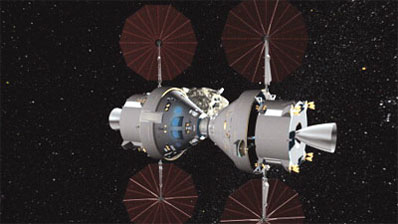

There were several recent news announcements of the EADS Astrium "Gravity Tractor" concept. This may be based upon a previous design developed by this EADS AStrium, the APEX or APophis EXplorer. Here is the abstract about the EADS Astrium "Apex" which was not specifically a gravity tractor mission but a radio beacon mission. Perhaps this was redesigned to be a gravity tractor spacecraft. Both systems seem to employ electric propulsion.
From an abstract presented at The First Meeting of The International Primitive Body Exploration Working Group (IPEWG), January 13-16, 2008, Bankoku Shinryokan, Okinawa, Japan:
APEX: A MISSION CONCEPT TO EXPLORE THE PHYSICAL PROPERTIES OF ASTEROID APOPHIS AND THEIR IMPACT ON ORBITAL EVOLUTION
Christian Trenkel (Astrium Ltd, Stevenage, UK), Paolo d’Arrigo (Astrium Ltd, Stevenage, UK), Simon Barraclough (Astrium Ltd, Stevenage, UK ) and Andrea Carusi (IASF, Rome, ITALY) [Contact E-mail : paolo.darrigo@astrium.eads.net]
On April 13th 2029, asteroid Apophis will have a close encounter with Earth, which could send it on a collision course with our planet, in 2036. The close encounter means that even a small shift in Apophis’ position in 2029, of the order of a few km, completely changes the outcome in 2036.
The orbit of Apophis is subject to a number of gravitational and non-gravitational perturbations, some of which are currently known with limited accuracy. These uncertainties are then amplified by the orbit propagation process and result in significant errors in position determination at the time of the close passage in 2029.
In late 2006, the Planetary Society issued the Apophis Mission Design Challenge, inviting the public to design a mission that would reduce the 3σ uncertainty in the position of Apophis in 2029, based on measurements taken by 2017, to about 14km. Astrium Ltd, UK, leading an international team, have submitted the APophis EXpress (APEX) proposal in response to this challenge.
A sensitivity analysis shows that the orbital parameters of Apophis need to be determined to equivalent absolute position uncertainties of a few metres, and absolute velocity uncertainties of around 0.2mm/s. Standard Radio Science Experiments (RSE) can achieve this accuracy, provided that all systematic effects and forces are adequately modeled. For Apophis, a complex non-gravitational force, the Yarkowski Effect (YE), can shift its position by over 100 km between 2017 and 2029. To meet the requirements, the YE needs to be determined with an accuracy of a few percent.
Analytical YE models exist only for a few special cases. A numerical model of the YE, based on in situ measurements of the relevant – mainly thermo-optical – asteroid properties, is therefore essential to reach the required accuracy. It is concluded that the successful orbit determination for Apophis is conditional upon a determination of its physical properties with unprecedented precision.
The APEX mission achieves this through the most detailed and extensive investigation of an asteroid ever performed. An orbiter, instrumented with a sophisticated remote sensing payload, will study Apophis for three years, from its arrival in early 2014 to early 20217. High resolution visual and thermal mapping campaigns will be followed by a RSE, with the ultimate goal of determining the orbital elements to parts per billion. These experiments will be repeated several times during the first year, in order to consolidate and complete the models used for orbit determination. The second and third year will be used to verify the accuracy of the orbit determination, and also allow time for additional mapping campaigns if necessary.
The relatively low gravity of Apophis (compared e.g. to Eros) represents a multiple challenge:
• The orbiter motion is influenced, to an unusually high degree, by non-gravitational forces. This results in most orbits being unstable. In addition, these forces have to be modeled, or directly measured, to very high accuracy.
• For remote sensing, ground track speeds tend to be very low (cm/s), making global mapping a slow process with standard orbits.
To meet these challenges, during radio science the APEX spacecraft is placed in the only stable low-altitude orbit around Apophis: a terminator orbit with the spacecraft keeping a constant cross section to solar radiation. This allows long manoeuvre-free periods when the spacecraft orbit can be tracked from Earth with great accuracy. Simultaneously, an on-board accelerometer is used to measure all non-gravitational perturbations. Finally, high resolution global mapping is achieved relatively quickly thanks to a forced fast orbit around Apophis, using the spacecraft’s own solar electric propulsion system to generate “artificial gravity”.
Link: Final Program and List of Abstracts: First Meeting of The International Primitive Body Exploration Working Group (IPEWG)
Link: EADS Astrium Press Release on APEX asteroid mission
























